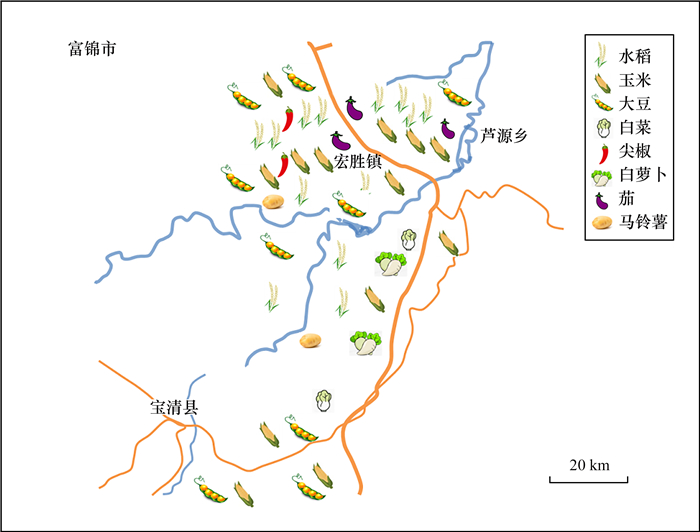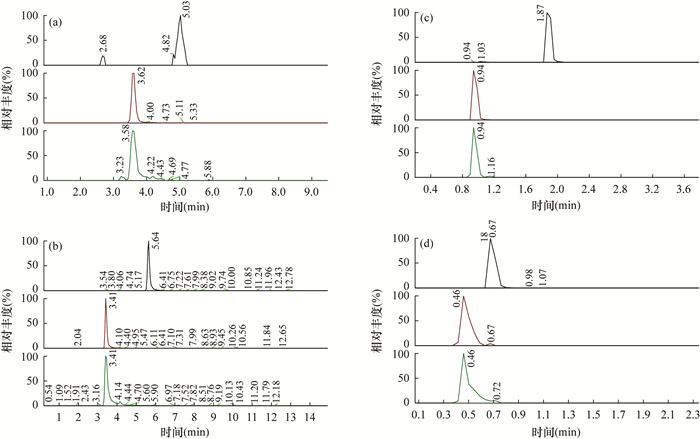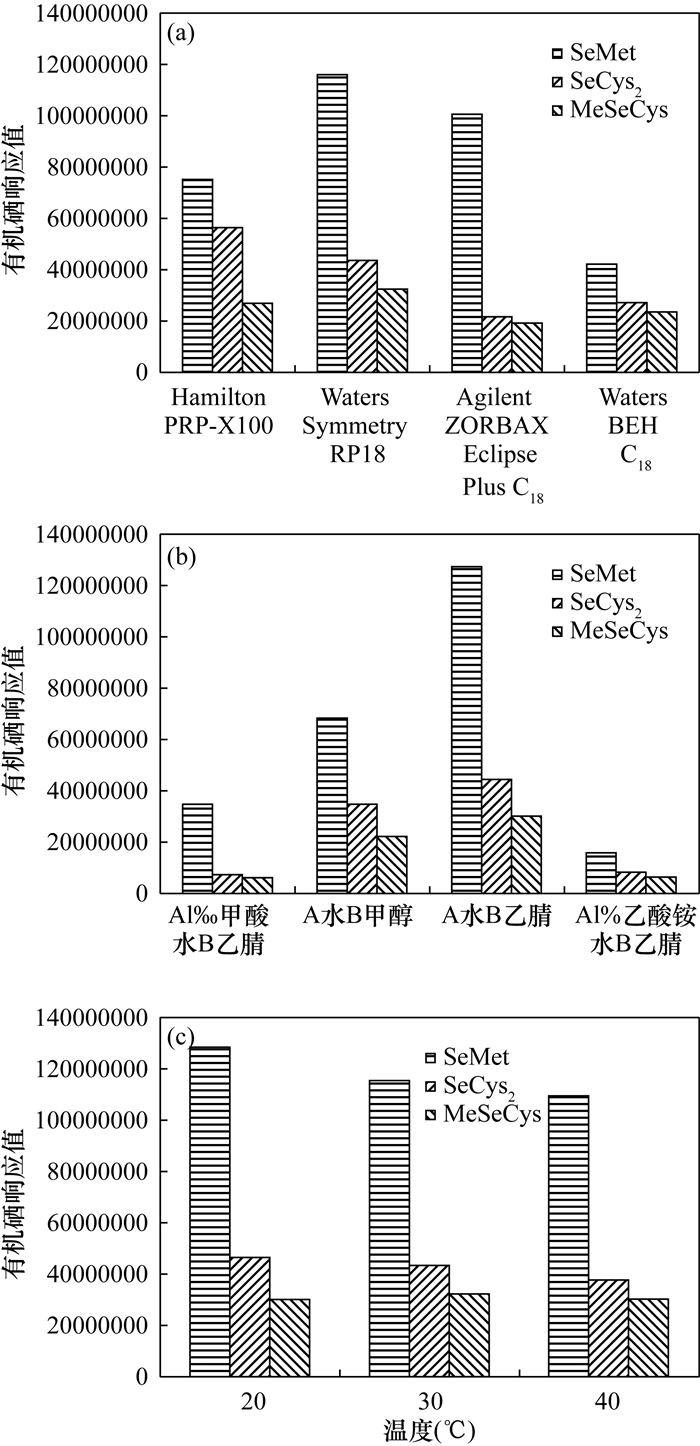Determination of Organic Selenium Compounds in Crops by Liquid Chromatography-Quadrupole/Electrostatic Field Orbitrap High-resolution Mass Spectrometry
-
摘要:
随着公众对富硒产品的关注,对富硒农作物中硒含量的研究越来越受到人们的重视。针对现有方法测定农作物有机硒的基体效应和多原子离子质谱干扰问题,本研究利用液相色谱与抗干扰能力强的四极杆/静电场轨道阱高分辨质谱相结合,建立了农产品中有机硒的形态分析方法。经优化以超声波辅助蛋白酶XIV提取农作物中有机硒,用Waters Symmetry RP18液相色谱柱分离,以纯水和乙腈作为流动相进行梯度洗脱,采用正、负离子切换同时测定了硒代蛋氨酸、硒代胱氨酸、甲基硒代半胱氨酸。三种有机硒在负离子模式下采用Full MS/dd-MS2扫描模式对目标物进行定性筛查和确证,三种有机硒在5~500μg/L的浓度范围内线性关系良好,相关系数均大于0.997,检出限为1.0~4.7μg/kg,回收率为76.4%~116.0%,相对标准偏差(RSD)≤6.5%。与现有方法比较,本方法线性范围宽,适用于多种谷物和蔬菜类样品的分析。将建立的方法应用于测定中国粮食主产区黑龙江地区多种农作物的可食部分,结果发现谷类中以硒代蛋氨酸为主,蔬菜类以甲基硒代半胱氨酸为主,并且该地区农作物的有机硒含量处于较低水平,亟待强化补硒。
-
关键词:
- 有机硒 /
- 农作物 /
- 四极杆/静电场轨道阱高分辨质谱法 /
- 超声酶提取
Abstract:BACKGROUND As more attention is paid to selenium-rich products, the research on the determination of selenium content in crops has become more and more significant. However, existing methods for determining organic selenium has interferences of the matrix effect and polyatomic ion, which affect the accuracy of the measurement.
OBJECTIVES To establish a rapid method to determine selenium species pf organic selenium in agricultural products by liquid chromatography-quadrupole/electrostatic field orbitrap high-resolution mass spectrometry (LC-Q Exactive Orbitrap MS).
METHODS The selenium species were extracted using an ultrasonic extraction system with a mixture of protease XIV. The separation was carried out on a Waters Symmetry RP18 column by gradient elution with water and acetonitrile as mobile phases. The selenomethionine, selenocystine and methylselenocysteine were simultaneously analyzed in switching positive and negative modes. The quantitative and qualitative analyses were carried out by high-resolution mass spectrometry with electrospray ionization (ESI) source in negative ion acquisition mode under Full MS/dd-MS2 mode.
RESULTS Under the optimal conditions, good linearity was obtained in the respective concentration ranges. The limits of detection for three compounds were in the range of 1.0-4.7μg/kg. The recoveries ranged from 76.4% to 116.0% with relative standard deviations less than 6.5%.
CONCLUSIONS Compared with existing methods, this method has a wider linear range and is suitable for the analysis of a variety of grain and vegetable samples. The established method has been applied to the determination of the edible part of a variety of crops in Heilongjiang, which is the main grain production area in China. The results show that selenomethionine is the main ingredient in cereals, and methylselenocysteine is the main ingredient in vegetables, and that the organic selenium content of crops in this area is at a low level. Therefore, selenium supplementation is urgently needed.
-

-
表 1 梯度洗脱程序
Table 1. Gradient elution procedure
时间(min) 流速(mL/min) 流动相A (%) 流动相B (%) 初始 0.300 97.0 3.0 8.0 0.300 85.0 15.0 9.0 0.300 50.0 50.0 10.0 0.300 10.0 90.0 12.0 0.300 10.0 90.0 12.5 0.300 97.0 3.0 16.5 0.300 97.0 3.0 表 2 三种有机硒的保留时间、精确质量数和相对质量偏差
Table 2. Retention times, accurate masses and relative deviations of three kinds of organic selenium
硒形态 保留时间(min) 精确质量数理论值(m/z) 精确质量数测定值(m/z) 相对质量偏差(10-6) SeMet 5.64 195.98822 195.98862 2.04 SeCyS2 3.41 334.90547 334.90593 1.37 MeSeCys 3.41 167.95692 167.95669 1.37 表 3 三种硒的线性方程、相关系数和检出限
Table 3. Regression equations, correlation coefficients and detection limit of three selenium species
硒形态 线性方程 相关系数(r) 检出限(μg/kg) 水稻籽粒 黄豆 玉米 白菜 马铃薯 白萝卜 SeMet y=302208+ 45923.1x 0.9997 1.0 1.7 1.2 1.3 1.8 1.4 SeCys2 y=-2987460+ 163256x 0.9982 2.5 3.4 2.3 2.6 3.5 2.7 MeSeCys y=1231460+ 63033.2x 0.9970 3.3 4.7 3.5 3.1 3.7 3.3 表 4 水稻籽粒中三种有机硒的加标回收率和精密度
Table 4. Standard recovery rate and precision tests of three kinds of organic selenium in rice grain
硒形态 添加量(μg/kg) 测量值(μg/kg) 加标回收率(%) RSD (%) SeMet 50. 0 42.7~51.3 89.2~102.6 5.1 1000.0 937.2~1060.1 93.7~106.0 3.7 5000.0 4930.0~5110.6 98.6~102.2 1.3 SeCys2 50.0 40.6~49.0 81.2~98.0 6.5 1000.0 998.3~1070.8 99.8~107.1 3.1 5000.0 4820.3~4960.5 96.4~99.2 0.9 MeSeCys 50.0 43.6~51.6 87.2~103.2 6.2 1000.0 1020.7~1160.2 102.1~116.0 4.7 5000.0 5070.6~5190.4 101.4~103.8 1.3 表 5 本方法与文献中相关分析方法的比较
Table 5. Comparison of performance with other methods in the references
硒形态 样品 样品提取方法 分析方法 线性范围(μg/L) 回收率(%) 检出限 来源文献 SeMet, SeCys2, MeSeCys, Se(Ⅳ), Se(Ⅵ) 谷类食品 超声酶提取 HPLC-ICP-MS 0.5~200.0 60.5~120.8 2.5~10.0μg/kg [30] SeMet, SeCys2, MeSeCys, Se(Ⅳ), Se(Ⅵ) 水稻籽粒 超声酶提取 HPLC-HG-AFS 10.0~200.0 85.4~105.5 2.27~3.89μg/L [31] SeMet 富硒面包 微波酶提取 HPLC-IDA-ICP-MS 20.0~100.0 68.0~84.0 0.7μg/L [32] SeMet, SeCys2, MeSeCys, Se(Ⅳ), Se(Ⅵ) 白菜 超声提取 HPLC-ICP-MS 0.0~200.0 52.1~111.6 0.85~4.68mg/mL [33] SeMet, SeCys2, MeSeCys 蔬菜和谷物 超声酶提取 LC-Q Exactive Orbitrap MS 5.0~500.0 76.4~116.0 1.0~4.7μg/kg 本文 表 6 部分检出农作物可食用部分有机硒含量
Table 6. Organic selenium content in edible parts of some plants
样品 有机硒含量(μg/kg) 无机硒转化率(%) 有机硒检出率(%) SeMet SeCys2 MeSeCys 总有机硒 总硒 水稻籽粒-1 92.0 12.7 ND 104.7 162.5 64.4 30.8 水稻籽粒-2 84.0 10.3 ND 94.4 135.2 69.8 水稻籽粒-3 11.7 ND ND 11.7 19.2 60.9 水稻籽粒-4 109.3 27.8 17.3 154.4 195.6 78.9 黄豆-1 43.4 27.3 11.1 81.8 112.7 72.6 44.4 黄豆-2 32.5 ND ND 32.5 45.3 71.7 黄豆-3 87.2 34.8 24.2 146.2 200.4 73.0 黄豆-4 45.6 12.5 ND 58.1 85.7 67.8 玉米-1 84.7 21.3 8.6 114.6 143.2 80.0 23.1 玉米-2 47.0 9.8 ND 57.3 89.4 64.1 玉米-3 58.0 34.7 ND 93.1 125.7 74.1 白菜 ND ND 8.0 8.0 21.4 37.4 50.0 马铃薯 5.6 ND 10.3 15.9 43.7 36.4 50.0 白萝卜 6.3 ND 9.0 15.3 42.8 35.7 50.0 注:ND表示未检出。 -
[1] Germ M, Stibilj V. Selenium and plants[J]. Acta Agriculturae Slovenica, 2007, 89(1): 65-71.
[2] Rayman M P. Selenium and human health[J]. The Lancet, 2012, 379: 1256-1268. doi: 10.1016/S0140-6736(11)61452-9
[3] Wichman J, Winther K H, Bonnema S J, et al. Selenium supplementation significantly reduces thyroid auto-antibody levels in patients with chronic autoimmune thyroiditis: A systematic review and meta-analysis[J]. Thyroid, 2016, 26(12): 1681-1692. doi: 10.1089/thy.2016.0256
[4] Wei J, Zeng C, Gong Q Y, et al. The association between dietary selenium intake and diabetes: Across-sectional study among middle-aged and older adults[J]. Nutrition Journal, 2015, 14(1): 18. doi: 10.1186/s12937-015-0007-2
[5] Labunskyy V M, Hatfield D L, Gladyshev V N. Selenoproteins: molecular pathways and physiological roles[J]. Physiological Reviews, 2014, 94(3): 739-777. doi: 10.1152/physrev.00039.2013
[6] Achibat H, Alomari N A, Messina F, et al. Organoselenium compounds as phytochemicals from the natural kingdom[J]. Natural Product Communications, 2015, 10(11): 1885-1892. http://smartsearch.nstl.gov.cn/paper_detail.html?id=19e6514ec141eb022dfdd3c135175b29
[7] Toan D Q, Cui Zewei C, Huang J H, et al. Selenium distribution in the Chinese environment and its relationship with human health: A review[J]. Environment International, 2018, 112: 294-309. doi: 10.1016/j.envint.2017.12.035
[8] Turło J, Gutkowska B, Herold F, et al. Biological availability and preliminary selenium speciation in selenium-enriched mycelium of Lentinula edodes (Berk. )[J]. Food Biotechnology, 2011, 25(1): 16-29. doi: 10.1080/08905436.2011.547113
[9] Liu K, Zhao Y, Chen F, et al. Purification and identification of Se-containing antioxidative peptides from enzymatic hydrolysates of Se-enriched brown rice protein[J]. Food Chemistry, 2015, 187: 424-430. doi: 10.1016/j.foodchem.2015.04.086
[10] Liu L, Yun Z, He B, et al. Efficient interface for online coupling of capillary eectrophoresis with inductively coupled plasma-mass spectrometry and its application in simultaneous speciation analysis of arsenic and selenium[J]. Analytical Chemistry, 2014, 86(16): 8167-8175. doi: 10.1021/ac501347d
[11] Foster L, Sumar S. Selenium in health and disease: A review[J]. Critical Reviews in Food Science & Nutrition, 1997, 37(3): 211-228.
[12] Hadrup N, Ravn-Haren G. Acute human toxicity and mortality after selenium ingestion: A review[J]. Journal of Trace Elements in Medicine and Biology, 2020, 58: 126435. doi: 10.1016/j.jtemb.2019.126435
[13] Zhou F, Dinh Q T, Yang W, et al. Assessment of spe-ciation and in vitro bioaccessibility of selenium in Se-enriched Pleurotus ostreatus and potential health risks[J]. Ecotoxicology and Environmental Safety, 2019, 185: 109675. doi: 10.1016/j.ecoenv.2019.109675
[14] Guzmán Mar J L, Reyes L H, Mizanur Rahman G M, et al. Simultaneous extraction of arsenic and selenium species from rice products by microwave-assisted enzymatic extraction and analysis by ion chromatography-inductively coupled plasma-mass spectrometry[J]. Journal of Agricultural and Food Chemistry, 2009, 57(8): 3005-3013. doi: 10.1021/jf803598k
[15] Vale G, Pereira S, Mota A, et al. Enzymatic probe sonication as a tool for solid-liquid extraction for total selenium determination by electrothermal-atomic absorption spectrometry[J]. Talanta, 2007, 74(2): 198-205. doi: 10.1016/j.talanta.2007.05.051
[16] Zhang X, Yang L, Mester Z. Determination of amino acids in selenium-enriched yeast by gas chromatography-mass spectrometry after microwave assisted hydrolysis[J]. Analytica Chimica Acta, 2012, 744: 54-59. doi: 10.1016/j.aca.2012.07.011
[17] Kannamkumarath S S, Wrobel K, Wuilloud R G. Study-ing the distribution pattern of selenium in nut proteins with information obtained from SEC-UV-ICP-MS and CE-ICP-MS[J]. Talanta, 2005, 66(1): 153-159. doi: 10.1016/j.talanta.2004.10.010
[18] Khanam A, Platel K. Bioavailability and bioactivity of selenium from wheat (Triticum aestivum), maize (Zea mays), and pearl millet (Pennisetum glaucum), in selenium-deficient rats[J]. Journal of Agricultural and Food Chemistry, 2019, 67(22): 6366-6376. doi: 10.1021/acs.jafc.9b02614
[19] do Nascimento da Silva E, Aureli F, D'Amato M, et al. Selenium bioaccessibility and speciation in selenium-enriched lettuce: Investigation of the selenocompounds liberated after in vitro simulated human digestion using two-dimensional HPLC-ICP-MS[J]. Journal of Agricultural and Food Chemistry, 2017, 65(14): 3031-3038. doi: 10.1021/acs.jafc.7b01188
[20] Hildebrand J, Greiner A, Drexler H, et al. Determination of eleven small selenium species in human urine by chromatographic-coupled ICP-MS methods[J]. Journal of Trace Elements in Medicine and Biology, 2020, 61: 126519. doi: 10.1016/j.jtemb.2020.126519
[21] Heinrichs H, Keltsch H. Determination of arsenic, bismuth, cadmium, selenium, and thallium by atomic absorption spectroscopy with a volatilization technique[J]. Analytical Chemistry, 1982, 54(7): 1211-1214. doi: 10.1021/ac00244a049
[22] Mohammed E, Mohammed T, Mohammed A. Optimization of instrument conditions for the analysis for mercury, arsenic, antimony and selenium by atomic absorption spectroscopy[J]. Methods, 2018, 5: 824-833. http://www.ncbi.nlm.nih.gov/pubmed/30112290
[23] Ma Y, Zeng K, Duan T. Fast and clean determination of total selenium in biological materials by an improved oxygen flask combustion method combined with hydride generation atomic fluorescence spectrometry[J]. Microchemical Journal, 2019, 148: 743-747. doi: 10.1016/j.microc.2019.04.064
[24] Tsopelas F N, Ochsenkühn-Petropoulou M T, Mergias I G, et al. Comparison of ultra-violet and inductively coupled plasma-atomic emission spectrometry for the on-line quantification of selenium species after their separation by reversed-phase liquid chromatography[J]. Analytica Chimica Acta, 2005, 539(1): 327-333. http://www.sciencedirect.com/science/article/pii/S0003267005003697
[25] Huang C, Li Q, Mo J, et al. Ultratrace determination of tin, germanium, and selenium by hydride generation coupled with a novel solution-cathode glow discharge-atomic emission spectrometry method[J]. Analytical Chemistry, 2016, 88(23): 11559-11567. doi: 10.1021/acs.analchem.6b02807
[26] Klencsár B, Li S, Balcaen L, et al. High-performance liquid chromatography coupled to inductively coupled plasma-mass spectrometry (HPLC-ICP-MS) for quantitative metabolite profiling of non-metal drugs[J]. TrAC Trends in Analytical Chemistry, 2018, 104: 118-134. doi: 10.1016/j.trac.2017.09.020
[27] D'Amato R, Regni L, Falcinelli B, et al. Current knowledge on selenium biofortification to improve the nutraceutical profile of food: A comprehensive review[J]. Journal of Agricultural and Food Chemistry, 2020, 68(14): 4075-4097. doi: 10.1021/acs.jafc.0c00172
[28] 韩梅, 侯雪, 邱世婷, 等. 超高效液相色谱-四极杆/静电场轨道阱高分辨质谱测定蔬菜中的百草枯[J]. 分析测试学报, 2019, 38(9): 1126-1131. doi: 10.3969/j.issn.1004-4957.2019.09.016
Han M, Hou X, Qiu S T, et al. Determination of paraquat in vegetables by ultra performance liquid chromatography-quadrupole/electrostatic field orbitrap high resolution mass spectrometry[J]. Journal of Instrumental Analysis, 2019, 38(9): 1126-1131. doi: 10.3969/j.issn.1004-4957.2019.09.016
[29] Bierla K, Flis-Borsuk A, Suchocki P, et al. Speciation of selenium in selenium-enriched sunflower oil by high-performance liquid chromatography-inductively coupled plasma mass spectrometry/electrospray-orbitrap tandem mass spectrometry[J]. Journal of Agricultural and Food Chemistry, 2016, 64(24): 4975-4981. doi: 10.1021/acs.jafc.6b01297
[30] 陈绍占, 唐德剑, 李晓玉, 等. 谷类食品中硒形态超声酶提取-高效液相色谱-电感耦合等离子体质谱法测定[J]. 中国公共卫生, 2020, 36(1): 130-136. https://www.cnki.com.cn/Article/CJFDTOTAL-ZGGW202001033.htm
Chen S Z, Tang D J, Li X Y, et al. Determination of selenium species in cereal food with ultrasonic enzyme extraction and high performance liquid chromatography-inductivel coupled plasma mass spectrometry[J]. China Journal Public Health, 2020, 36(1): 130-136. https://www.cnki.com.cn/Article/CJFDTOTAL-ZGGW202001033.htm
[31] 胡文彬, 贾彦博, 魏琴芳, 等. 应用液相色谱-原子荧光联用仪测定富硒大米中的5种硒形态[J]. 分析仪器, 2019(1): 120-124. doi: 10.3969/j.issn.1001-232x.2019.01.024
Hu W B, Jia Y B, Wei Q F, et al. Determination of selenium form in selenium-rich rice by liquid chromatography-hydride generation atomic fluorescence spectrometry[J]. Analytical Instrumentation, 2019(1): 120-124. doi: 10.3969/j.issn.1001-232x.2019.01.024
[32] Sánchez-Martínez M, Pérez-Corona T, Cámara C, et al. Preparation and characterization of a laboratory scale selenomethionine-enriched bread. Selenium bioaccessibility[J]. Journal of Agricultural and Food Chemistry, 2015, 63(1): 120-127. doi: 10.1021/jf505069d
[33] Thosaikham W, Jitmanee K, Sittipout R, et al. Evaluation of selenium species in selenium-enriched pakchoi (Brassica chinensis Jusl var parachinensis (Bailey) Tsen & Lee) using mixed ion-pair reversed phase HPLC-ICP-MS[J]. Food Chemistry, 2014, 145: 736-742. doi: 10.1016/j.foodchem.2013.08.116
[34] Cubadda F, Aureli F, Ciardullo S, et al. Changes in sele-nium speciation associated with increasing tissue concentrations of selenium in wheat grain[J]. Journal of Agricultural and Food Chemistry, 2010, 58(4): 2295-2301. doi: 10.1021/jf903004a
[35] 邵鹏威, 路国慧, 郑宇, 等. 高效液相色谱-电感耦合等离子体质谱测定大米粉中的硒形态[J]. 环境化学, 2020, 39(5): 1434-1441. https://www.cnki.com.cn/Article/CJFDTOTAL-HJHX202005031.htm
Shao P W, Lu G H, Zheng Y, et al. Determination of selenium species in rice flour using high performance liquid chromatography-inductively coupled plasma mass spectrometry[J]. Environmental Chemistry, 2020, 39(5): 1434-1441. https://www.cnki.com.cn/Article/CJFDTOTAL-HJHX202005031.htm
[36] Díaz-Alarcón J P, Navarro-Alarcón M, Serrana H G, et al. Determination of selenium in cereals, legumes and dry fruits from southeastern Spain for calculation of daily dietary intake[J]. Science of the Total Environment, 1996, 184(3): 183-189. doi: 10.1016/0048-9697(96)05079-6
[37] Lu X, He Z, Lin Z, et al. Effects of Chinese cooking methods on the content and speciation of selenium in selenium bio-fortified cereals and soybeans[J]. Nutrients, 2018, 10(3): 1-10. http://www.ncbi.nlm.nih.gov/pubmed/29518925
-




 下载:
下载:


